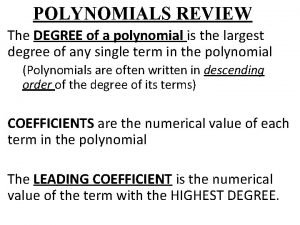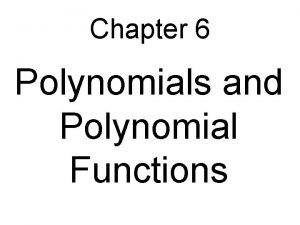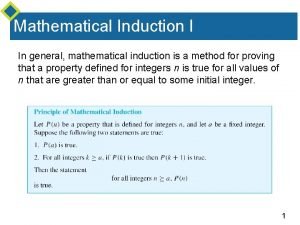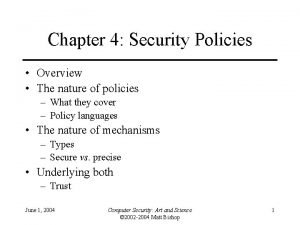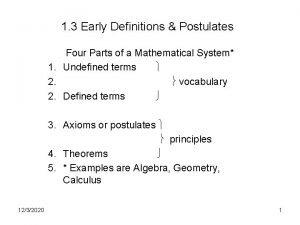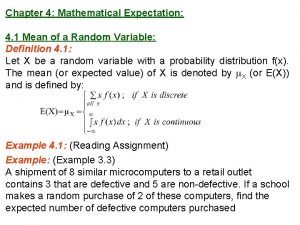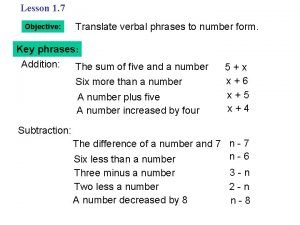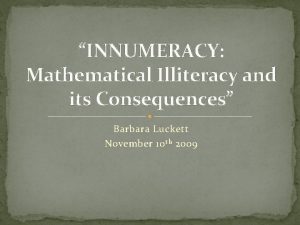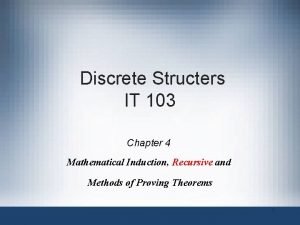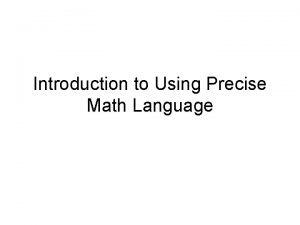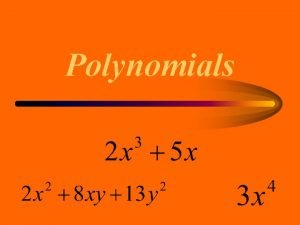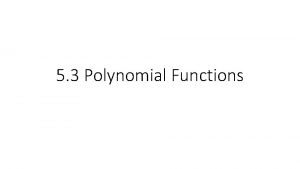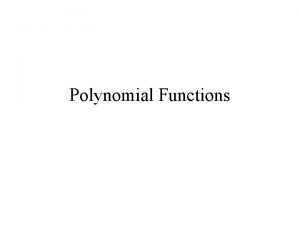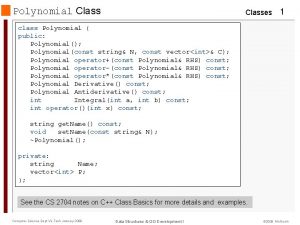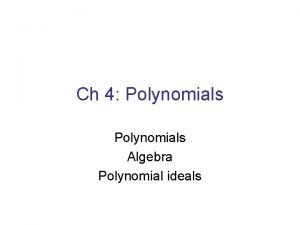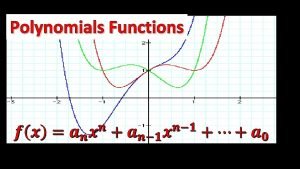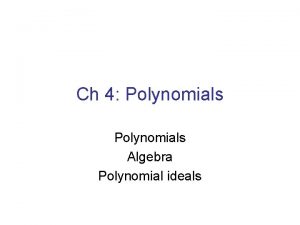Polynomials Polynomials Polynomial A polynomial is a mathematical


















































- Slides: 50

Polynomials

Polynomials

Polynomial A polynomial is a mathematical expression involving a sum of powers in one or more variables multiplied by coefficients. A polynomial in one variable (i. e. , a univariate polynomial) with constant coefficients is given by e. g. - anxn+a 2 x 2+a 1 x+a 0

Vocabulary Monomials - a number, a variable, or a product of a number and one or more variables. 4 x, 20 x 2 yw 3, -3, a 2 b 3, and 3 yz are all monomials. Polynomials – one or more monomials added or subtracted. 4 x + 6 x 2, 20 xy - 4, and 3 a 2 - 5 a + 4 are all polynomials.

Like Terms refers to monomials that have the same variable(s) but may have different coefficients. The variables in the terms must have the same powers. Which terms are like? 3 a 2 b, 4 ab 2, 3 ab, -5 ab 2 4 ab 2 and -5 ab 2 are like. Even though the others have the same variables, the exponents are not the same. 3 a 2 b = 3 aab, which is different from 4 ab 2 = 4 abb.

Like Terms Constants are like terms. Which terms are like? 2 x, -3, 5 b, 0 -3 and 0 are like. Which terms are like? 3 x, 2 x 2, 4, x 3 x and x are like. Which terms are like? 2 wx, w, 3 x, 4 xw 2 wx and 4 xw are like.

Operation on Polynomial Addition Subtraction Multiplication Division

Adding a Polynomial Add: (x 2 + 3 x + 1) + (4 x 2 +5) Step 1: Underline like terms: (x 2 + 3 x + 1) + (4 x 2 +5) Notice: ‘ 3 x’ doesn’t have a like term. Step 2: Add the coefficients of like terms, do not change the powers of the variables: (x 2 + 4 x 2) + 3 x + (1 + 5) 5 x 2 + 3 x + 6

Adding a Polynomial Some people prefer to add polynomials by stacking them. If you choose to do this, be sure to line up the like terms! (x 2 + 3 x + 1) + (4 x 2 +5) 5 x 2 + 3 x + 6 Stack and add these polynomials: (2 a 2+3 ab+4 b 2) + (7 a 2+ab+-2 b 2) (2 a 2 + 3 ab + 4 b 2) (2 a 2+3 ab+4 b 2) + (7 a 2+ab+-2 b 2) + (7 a 2 + ab + -2 b 2) 9 a 2 + 4 ab + 2 b 2

Activity!! Add the following polynomials; you may stack them if you prefer:

Subtracting a Polynomial Subtract: (3 x 2 + 2 x + 7) - (x 2 + x + 4) Step 1: Change subtraction to addition (Keep-Change. ). (3 x 2 + 2 x + 7) + (- x 2 + - x + - 4) Step 2: Underline OR line up the like terms and add. (3 x 2 + 2 x + 7) + (- x 2 + - x + - 4) 2 x 2 + x + 3

Activity!! Subtract the following polynomials by changing to addition (Keep-Change. ), then add:

Multiplying a Polynomial

Review The Distributive Property Look at the following expression: 3(x + 7) This expression is the sum of x and 7 multiplied by 3. (3 • x) + (3 • 7) 3 x + 21 To simplify this expression we can distribute the multiplication by 3 to each number in the sum.

Review Whenever we multiply two numbers, we are putting the distributive property to work. 7(23) We can rewrite 23 as (20 + 3) then the problem would look like 7(20 + 3). Using the distributive property: (7 • 20) + (7 • 3) = 140 + 21 = 161 When we learn to multiply multi-digit numbers, we do the same thing in a vertical format.

Review 2 23 x____ 7 16 7 • 3 = 21. Keep the 1 in the ones position then carry the 2 into the tens position. 7 • 2 = 14. Add the 2 from before and we get 16. What we’ve really done in the second step, is multiply 7 by 20, then add the 20 left over from the first step to get 160. We add this to the 1 to get 161.

Multiplying a Polynomial Multiply: 3 xy(2 x + y) This problem is just like the review problems except for a few more variables. To multiply we need to distribute the 3 xy over the addition. 3 xy(2 x + y) = (3 xy • 2 x) + (3 xy • y) = 6 x 2 y + 3 xy 2 Then use the order of operations and the properties of exponents to simplify.

Multiplying a Polynomial We can also multiply a polynomial and a monomial using a vertical format in the same way we would multiply two numbers. Multiply: 7 x 2(2 xy – 3 x 2) 2 xy – 3 x 2 x____ 7 x 2 14 x 3 y – 21 x 2 Keep track of negative signs. Align the terms vertically with the monomial under the polynomial. Now multiply each term in the polynomial by the monomial.

Multiplying a Polynomial To multiply a polynomial by another polynomial we use the distributive property as we did before. Multiply: (x + 3)(x – 2) (x + 3) (x – 2) x____ 2 x – 6 x 2 + 3 x + 0 _____ x 2 + 5 x – 6 Line up the terms by degree. Multiply in the same way you would multiply two 2 -digit numbers. Remember that we could use a vertical format when multiplying a polynomial by monomial. We can do the same here.

Multiplying a Polynomial To multiply the problem below, we have distributed each term in one of the polynomials to each term in the other polynomial. Multiply: (x + 3)(x – 2) (x + 3) x____ (x – 2) 2 x – 6 2 + 3 x + 0 x_____ x 2 + 5 x – 6 Here is another example. (x 2 – 3 x + 2)(x 2 – 3) (x 2 – 3 x + 2) Line up like terms. 2 x______ (x – 3) – 3 x 2 + 9 x – 6 x 4 – 3 x 3 + 2 x 2 + 0 x + 0 _________ x 4 – 3 x 3 – 1 x 2 + 9 x – 6

Multiplying a Polynomial It is also advantageous to multiply polynomials without rewriting them in a vertical format. Though the format does not change, we must still distribute each term of one polynomial to each term of the other polynomial. Multiply: (x + 2)(x – 5) Each term in (x+2) is distributed to each term in (x – 5).

Multiplying a Polynomial Multiply the First terms. O Multiply the Outside terms. F (x + 2)(x – 5) I L Multiply the Inside terms. Multiply the Last terms. After you multiply, collect like terms. This pattern for multiplying polynomials is called FOIL.

Multiplying a Polynomial Example: (x – 6)(2 x + 1) x(2 x) + x(1) – (6)2 x – 6(1) 2 x 2 + x – 12 x – 6 2 x 2 – 11 x – 6

Activity !! 1. 2 x 2(3 xy + 7 x – 2 y) 2. (x + 4)(x – 3) 3. (2 y – 3 x)(y – 2)

2 x 2(3 xy + 7 x – 2 y) 2 x 2(3 xy) + 2 x 2(7 x) + 2 x 2(– 2 y) 6 x 3 y + 14 x 2 – 4 x 2 y



Dividing a Polynomial Simple Division -dividing a polynomial by a monomial

Dividing a Polynomial

Dividing a Polynomial

x-8 -(x 2 + 3 x ) x 2/x = x - 8 x - 24 -( - 8 x - 24 ) -8 x/x = -8 0

h 2 -( h 3/h = h 2 + 4 h +5 - 4 h 2 ) 4 h 2 - 11 h -( 4 h 2 - 16 h ) 5 h + 28 4 h 2/h = 4 h -( 5 h/h = 5 5 h - 20 48 )

Dividing a Polynomial Synthetic Divisiondivide a polynomial by a polynomial To use synthetic division: There must be a coefficient for every possible power of the variable. The divisor must have a leading coefficient of 1.

Dividing a Polynomial Step #1: Write the terms of the polynomial so the degrees are in descending order. Since the numerator does not contain all the powers of x, you must include a 0 for the x.

Dividing a Polynomial Step #2: Write the constant r of the divisor x-r to the left and write down the coefficients. 5 0 -4 Since the divisor is x-3, r=3 1 6

Dividing a Polynomial Step #3: Bring down the first coefficient, 5. 5

Dividing a Polynomial Step #4: Multiply the first coefficient by r, so and place under the second coefficient then add. 15 5 15

Dividing a Polynomial Step #5: Repeat process multiplying the sum, 15, by r; and place this number under the next coefficient, then add. 5 15 15 15 45

Dividing a Polynomial Step #5 cont. : Repeat the same procedure. Where did 123 and 372 come from? 5 15 15 45 124 15 378

Dividing a Polynomial Step #6: Write the quotient The numbers along the bottom are coefficients of the power of x in descending order, starting with the power that is one less than that of the dividend. 5 15 45 123 372 15 41 124 378

Dividing a Polynomial The quotient is: Remember to place the remainder over the divisor.

Dividing a Polynomial Step#1: Powers are all accounted for and in descending order. Step#2: Identify r in the divisor. Since the divisor is x+4, r=-4.

Dividing a Polynomial Step#3: Bring down the 1 st coefficient. Step#4: Multiply and add. Step#5: Repeat. -5 20 -1 4 1 -4 0 0 8 -2 10

Dividing a Polynomial Notice the leading coefficient of the divisor is 2 not 1. We must divide everything by 2 to change the coefficient to a 1.

Dividing a Polynomial 3

Dividing a Polynomial *Remember we cannot have complex fractions - we must simplify.

Dividing a Polynomial 1 Coefficients

Dividing a Polynomial

Apllication Bagatrix Calculator Apps

 Elements of mathematical economics
Elements of mathematical economics Degree 5 graph
Degree 5 graph Unit 6 polynomials and polynomial functions
Unit 6 polynomials and polynomial functions Matplotlib inline
Matplotlib inline How to divide a polynomial by another polynomial
How to divide a polynomial by another polynomial Mathematical proficiency
Mathematical proficiency Maths literacy conversion table
Maths literacy conversion table Mathematical literacy nqf level 3
Mathematical literacy nqf level 3 Principle of mathematical induction
Principle of mathematical induction Mathematical foundations of computer graphics and vision
Mathematical foundations of computer graphics and vision Mathematical proof
Mathematical proof How to cheat in
How to cheat in Spoon
Spoon Qutub minar mathematical information
Qutub minar mathematical information Shabana ka matlab
Shabana ka matlab Four parts of the mathematical system.
Four parts of the mathematical system. Algebra of propositions
Algebra of propositions Nx mentoring
Nx mentoring Mathematical problems
Mathematical problems Vdoe rich math tasks
Vdoe rich math tasks Ano ang demand function
Ano ang demand function Definition of mathematical expectation
Definition of mathematical expectation Math scanner
Math scanner Mathematical induction
Mathematical induction What is mathematical sentence
What is mathematical sentence Innumeracy examples
Innumeracy examples Measurement maths literacy grade 12
Measurement maths literacy grade 12 What is interest in mathematical literacy
What is interest in mathematical literacy Mathematical rebus
Mathematical rebus Types of mathematical models
Types of mathematical models Introduction and mathematical concepts
Introduction and mathematical concepts Normal forms in mathematical logic
Normal forms in mathematical logic Mathematical modeling and engineering problem solving
Mathematical modeling and engineering problem solving Principles to actions
Principles to actions Mathematical literacy grade 12 exchange rate
Mathematical literacy grade 12 exchange rate Geometric series proof by induction
Geometric series proof by induction Proposition in math
Proposition in math Jon keating
Jon keating Sigma notation word problems
Sigma notation word problems Rotational mechanical system example
Rotational mechanical system example Induction math
Induction math Induksi matematika
Induksi matematika Example of existential universal statement
Example of existential universal statement Franco's fast food maths problem answer
Franco's fast food maths problem answer Mathematics is precise
Mathematics is precise Boiling point definition
Boiling point definition Mathematical model of liquid level system
Mathematical model of liquid level system Challenges for more able pupils
Challenges for more able pupils Mathematical techniques
Mathematical techniques Strip map mathematical literacy
Strip map mathematical literacy Mathematical illusions
Mathematical illusions

